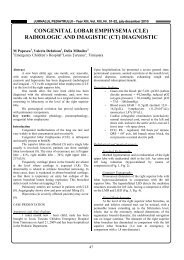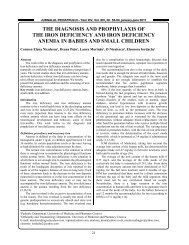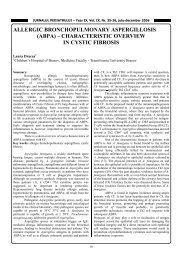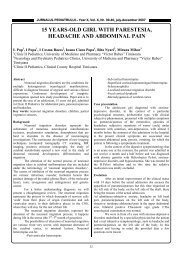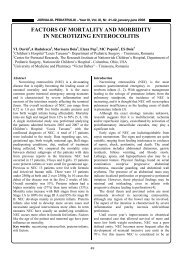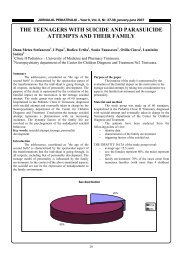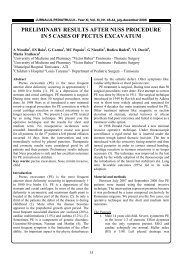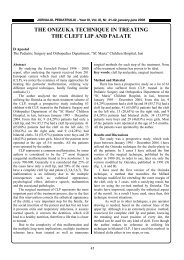ETIOPATHOGENY OF CONGENITAL CARDIAC MALFORMATIONS
ETIOPATHOGENY OF CONGENITAL CARDIAC MALFORMATIONS
ETIOPATHOGENY OF CONGENITAL CARDIAC MALFORMATIONS
You also want an ePaper? Increase the reach of your titles
YUMPU automatically turns print PDFs into web optimized ePapers that Google loves.
JURNALUL PEDIATRULUI – Year XIII, Vol. XIII, Nr. 51-52, july-december 2010<br />
<strong>ETIOPATHOGENY</strong> <strong>OF</strong> <strong>CONGENITAL</strong><br />
<strong>CARDIAC</strong> <strong>MALFORMATIONS</strong><br />
Elena Veronica Maria 1 , Antonia Popescu 2 , Georgeta Cornitescu 1 , Ileana Puiu 1<br />
1 University of Medicine and Pharmacy, Craiova<br />
2 University of Medicine and Pharmacy, Cluj-Napoca<br />
Abstract<br />
The prevention of congenital cardiac malformations<br />
has long been hampered by a lack of information regarding<br />
the modifiable risk factors. Over the last century there has<br />
been a major progress on understanding the genetic causes<br />
of congenital cardiac diseases, but also on identifying the<br />
genetic anomalies specific for certain types of<br />
malformations. The percentage of cases that could be<br />
prevented through changes in the fetal environment is<br />
unknown at the moment. A study suggests that the fraction<br />
of identifiable imputable causes and which could be<br />
modified can reach 30% for certain types of defects. The<br />
purpose of this paper is to analyze the present situation of<br />
knowledge regarding the teratogenetic, genetic and risk<br />
factors, of cardiac structural anomalies, in order to establish<br />
guidelines for the change of the future parents’ lifestyle and<br />
for a better monitoring of pregnancies. The study of<br />
teratogenetic factors has focused on those which can<br />
influence the cardiac development during the gestation<br />
weeks, taking into account also the limitation of the period<br />
of exposure before pregnancy (3 months) and during the<br />
first quarter of pregnancy.<br />
Keywords: etiopathogeny, congenital cardiac<br />
malformations, child<br />
Introduction<br />
The epidemiology of noninfectious diseases<br />
establishes the prevalence and association between certain<br />
diseases and the factors involved in etiology and pathogeny.<br />
Information obtained, represents a solid argument for the<br />
introduction of surveillance measures for monitoring both<br />
the population’s health status and the national programs of<br />
public health.<br />
On the basis of epidemiologic data, in the developed<br />
countries there has been established that congenital cardiac<br />
malformations (CCM) represent a priority problem for the<br />
public health, since they represent 25% of the total of<br />
malformations.<br />
Congenital cardiac malformations, according to a<br />
definition by Mitchell and el, represent “structural<br />
anomalies of the heart or of the major vessels at the base of<br />
the heart, present at birth, having or which will be having a<br />
functional echo”(1,2). Most of them originate in the<br />
abnormal morphogenesis of the primitive cardiac tube in the<br />
first 50 days of embryonic life.<br />
Recognized associations are consigned in Down,<br />
Noonan, Turner, Williams, Marfan or Holt-Oram<br />
syndromes. 40% of the children with Down’s syndrome<br />
present an atrio-ventricular channel, while most of those<br />
with Turner’s syndrome present obstructive lesions of the<br />
left heart (3).<br />
Approximately 0.8 % of the viable births are<br />
complicated by a cardiovascular malformation. This aspect<br />
doesn’t take into account the most frequent two cardiac<br />
anomalies: the bicuspid aortic valve disease and the valvular<br />
anomaly associated with the mitral valve prolapse. Recent<br />
studies indicate greater incidences than those that are known<br />
regarding VSD, the persistence of both the left superior<br />
vena cava and the atrial septal aneurysm. Hence, it is<br />
revealed very clearly that the old statistical analyses have<br />
underestimated a lot the incidence of the congenital<br />
cardiopathies, the recent studies forecasting an incidence of<br />
50 to 1000 live newborns (4).<br />
The huge progress achieved with respect to diagnosis<br />
and treatment of congenital cardiac malformations will be<br />
followed by the prolongation of these persons’ life, with the<br />
possibility to come to maturity and reproduce.<br />
On the other hand, despite the advanced therapies<br />
available at present, the morbidity and mortality associated<br />
with some types of congenital cardiac malformations are<br />
still significant (for instance the hypoplastic left heart<br />
syndrome).<br />
<strong>ETIOPATHOGENY</strong><br />
GENETIC FACTORS<br />
For the clinician whose job is to look after children<br />
with congenital cardiac malformations, it is very important<br />
to know if these defects are due to genetic modifications, for<br />
the following reasons:<br />
- other system of organs might be affected too;<br />
- he can establish a diagnosis for the clinical evolution;<br />
- the family should be informed about the risk of recurrence<br />
in phratria which is higher than that of the general<br />
population;<br />
- establishing a genetic cause imposes the genetic testing<br />
also of the other members of the family.<br />
GENETIC TESTS USED IN THE EVALUATION <strong>OF</strong><br />
<strong>CONGENITAL</strong> <strong>CARDIAC</strong> <strong>MALFORMATIONS</strong><br />
The genetic tests used to establish the genetic<br />
modifications in children with congenital cardiac<br />
malformations include cytogenetic techniques, fluorescence<br />
in situ hybridization (FISH) and the analysis of the DNA<br />
mutations.<br />
Before using the cytogenetic techniques, the standard<br />
analysis of chromosomes established the presence of<br />
3
JURNALUL PEDIATRULUI – Year XIII, Vol. XIII, Nr. 51-52, july-december 2010<br />
chromosomal aberrations between 8-13% in newborns with<br />
congenital cardiac malformations. This percentage has<br />
increased since the molecular techniques were used (5).<br />
The standard analysis of the metaphase karyotype is<br />
useful especially for the diagnosis of chromosomal<br />
affections which involve the modification of the number of<br />
chromosomes. A more sensitive test and the high-resolution<br />
stripes define better the structural chromosomal anomalies.<br />
The FISH cytogenetic technique diagnoses the<br />
microdeletions, small overlaps and subtle translocations.<br />
The Williams, Alagille and DiGeorge syndromes can be<br />
diagnosed only by using this FISH technology.<br />
If the karyotype is normal in a patient suffering from<br />
facial dimorphism, congenital anomalies (including heart<br />
anomalies) and mental and physical development<br />
retardation, the subtelomeric FISH studies are indicated as<br />
well as additional examinations of the other members of the<br />
family.<br />
The families in which a subtelomeric malformation is<br />
identified should receive medical advice from a genetician<br />
who is able to offer them the adequate criteria of evaluation.<br />
Other genetic techniques involve methods of<br />
discovery of the genes which have caused the disease (by<br />
cloning the gene) and analysis of the DNA mutations. The<br />
scope and heterogeneity of the genes and mutations<br />
identified so far, suggest that they are associated with a<br />
variety of pathogenetic mechanisms, including the loss of<br />
expression and inactivation, or the loss or gain in a function<br />
through allelic mutation.<br />
The challenge of the future is to define the<br />
pathogenesis that causes mutations and which in its turn,<br />
will offer the opportunity to develop diagnosis and<br />
treatment strategies, as alternatives to those used so far.<br />
CYTOGENETIC TESTING<br />
It is necessary in the following situations:<br />
● any infant or child with a phenotype of known<br />
chromosomal syndrome;<br />
● any infant or child with congenital cardiac<br />
malformations associated with:<br />
1. facial dimorphism;<br />
2. statural retardation that cannot be attributed<br />
to cardiac malformation;<br />
3. mental retardation;<br />
4. other congenital anomalies.<br />
● infants or children with a family background in<br />
multiple abortions and/or brothers with congenital<br />
malformations;<br />
● prenatal ecographic diagnosis of a major cardiac<br />
malformation and/or of visceral malformations.<br />
The identification of the genetic cause is beneficial<br />
because it allows for an examination of the other members<br />
of the family, the genotyping being very useful. The persons<br />
with negative genotype have a low risk for cardiovascular<br />
malformations and their clinical examination is not<br />
necessary. The persons with positive genotype will be<br />
periodically examined, to monitor the development of the<br />
phenotype.<br />
ETHICAL CONSIDERATIONS<br />
The genetic predictive testing of children and<br />
adolescents must not take place as a direct result of the<br />
testing before the patient has reached the age of 18, except<br />
when there are clinical benefits.<br />
The genetic testing can establish a genetic<br />
mechanism of the disease which offers an important<br />
opportunity for the genetic counseling of the whole family.<br />
TERATOGENETIC FACTORS<br />
Teratogenetic factors are responsible only for a minor<br />
part of congenital cardiac malformations, but they have a<br />
great “quality”- they are “modifiable”.<br />
The environmental or exposure conditions during<br />
pregnancy have been classified into 5 categories:<br />
1. factors which can be associated with a low risk<br />
for congenital cardiac malformations;<br />
2. factors which can be associated with a high<br />
risk for congenital cardiac malformations;<br />
3. factors for which information regarding the<br />
risk for congenital cardiac malformations are<br />
unconvincing;<br />
4. factors that have been studied, but for which<br />
there haven’t been found associations with<br />
congenital cardiac malformations up to the<br />
present;<br />
5. factors which have been studied, but for which<br />
there is too little available information to<br />
determine the risk (6).<br />
Up to the present, there have not been published<br />
prospective comprehensive studies that would examine<br />
environmental exposures or exposures of other nature,<br />
associated with congenital cardiac malformations.<br />
The best information available is from large<br />
populations, extracted from case-control studies specially<br />
conceived to investigate possible risk factors for congenital<br />
cardiac malformations.<br />
Two studies deserve to be mentioned - Baltimore-<br />
Washington Infant (BWI) (prospective study) (7), and The<br />
Study of the National Institute for Public Health, in Helsinki<br />
(8).<br />
MULTIVITAMINS AND FOLIC ACID<br />
Recent discoveries state that the use of additional<br />
multivitamins before pregnancy, that contain folic acid,<br />
can reduce the risk for congenital cardiac malformations,<br />
that is similar to that for neural tube defects. This result was<br />
obtained for the fist time following the analysis of the data<br />
from a random study. The supplement of folic acid was<br />
associated with a global reduction of 60% of the risk for<br />
congenital cardiac malformations (9), and of 25% in another<br />
case-control study conducted in Atlanta (10). Other studies<br />
showed a drop in a one congenital cardiac malformation,<br />
and not in all. For SDV two studies showed a reduction in<br />
the risk by 40%, and respectively 85%. (10).<br />
The studies conducted on high-risk groups bring<br />
justifiable evidence in correspondence with the protective<br />
effect of the supplements of folic acid multivitamins:<br />
4
JURNALUL PEDIATRULUI – Year XIII, Vol. XIII, Nr. 51-52, july-december 2010<br />
- in women who have used medications that<br />
contain folic acid antagonists (11);<br />
- in maternal febrile diseases (12);<br />
Similar conclusions have been reported also<br />
for other malformations (13).<br />
MATERNAL DISEASES<br />
Maternal fenilcetonuria<br />
If untreated, it is associated with a 6-time increase in<br />
the risk for congenital cardiac malformations (14). The most<br />
frequent are tetralogy of Fallot, VSD, CPA and single<br />
ventricle defect. The control of diet before pregnancy and<br />
during pregnancy reduces this risk (15).<br />
Maternal diabetes<br />
Congenital cardiac diseases have been constantly<br />
associated with pregestational diabetes and less with the<br />
gestational one (7,16). The associated specific types are:<br />
transposition of great vessels, atrial septal and<br />
nonchromosal ventricular defects, left heart hypoplasia,<br />
outflow tract defects and CPA (7,17). Malformations appear<br />
before the seventh week of pregnancy (18), with a direct<br />
relation between their appearance and the glycemic control<br />
during organogenesis (19). The strict control of glycaemia<br />
before and during pregnancy reduces the risk at levels<br />
comparable with those of the general population (20).<br />
Taking into account the increase in the prevalence of<br />
risk factors for diabetes mellitus, it is important to obtain a<br />
better understanding of the present impact of both types of<br />
diabetes in congenital cardiac malformations (21).<br />
The mechanisms suspected to be involved are:<br />
- the high level of glycaemia would perturb the<br />
expression of a regulatory gene leading to<br />
embriotoxic apoptosis (22);<br />
- the oxidative stress which results form the<br />
metabolic disorders and free radicals (23).<br />
Rubella, febrile diseases, flue<br />
Maternal infection with rubella during pregnancy is<br />
associated with congenital rubella syndrome. Of the cardiac<br />
malformations the most frequently associated are: CPA,<br />
pulmonary valve anomalies, peripheral pulmonary stenosis,<br />
VSD (24). The risk for rubellic embriopathy can be<br />
eliminated by guaranteeing that women of fertile age<br />
received their anti-rubella vaccine (25).<br />
Several recent studies have pointed out that any<br />
febrile disease, including flue, during the first quarter of<br />
pregnancy increases twice the risk for congenital cardiac<br />
malformations, (pulmonary stenosis, tricuspid atresia, aortic<br />
coarctation, conotruncal defects, VSD) ( 7,12).<br />
One of the possible mechanisms is the change in<br />
apoptosis which is involved in cardiac morphogenesis (26).<br />
Changes can be due to fever, infection itself, or use of<br />
medications to combat the fever or infection.<br />
Obesity<br />
Conclusions were not constant regarding the<br />
contribution of obesity as a teratogenetic factor in the<br />
appearance of congenital cardiac malformations. A study<br />
reported an association between an index of corporal mass ><br />
26 Kg/m 2 with a group of malformations of the great vessels<br />
(27). Other studies reported an increase between 2 and 6<br />
times in the risk for congenital cardiac malformations (28).<br />
This infection seems to be rather a predisposing<br />
factor than a teratogenetic one. Nevertheless, obesity is a<br />
complex condition which should be studied carefully,<br />
because it can be associated with other nutritive factors or<br />
type 2 diabetes mellitus.<br />
HIV infection<br />
This infection can be transmitted vertically from<br />
mother to fetus. Children infected through in utero HIV1<br />
transmission are subject to an increased risk of dilatative<br />
cardiomyopathy and left ventricular hypertrophy (29), but at<br />
the moment not to cardiovascular congenital structural<br />
malformations.<br />
Epilepsy<br />
The risk for children born by epileptic mother is high.<br />
However, it has been quite difficult to establish whether<br />
maternal convulsions are independently responsible for this<br />
fact or it should be taken into consideration only the<br />
treatment through the direct action of anticonvulsants or<br />
their indirect action through the interference of the folic acid<br />
metabolism (30).<br />
MATERNAL EXPOSURE TO THERAPEUTIC DRUGS<br />
U.S. Food and Drug Administration have classified a<br />
series of medications depending on their risk for causing<br />
congenital malformations, if used during pregnancy.<br />
Thalidomide<br />
It is known to be a cardiac teratogen, malformations<br />
caused by it varying from atrial and ventricular septal<br />
defects to complex conotruncal defects.<br />
Vitamin A congeners/retinoids<br />
The maternal contribution of isotretinoin causes<br />
congenital cardiac malformations. The characteristics of<br />
embriopathy caused by the isotretinoin are: central nervous<br />
system malformations, micrognathia, palatoschizis, thymus<br />
malformations, ocular, cardiac and great vessels<br />
malformations. The frequency of malformations does not<br />
seem to be high in persons having interrupted the treatment<br />
before conception (31). These medications are<br />
contraindicated during pregnancy and among women who<br />
are on the verge of receiving in vitro fertilization. Etretinate<br />
persists for a long time inside the body after the treatment<br />
has been stopped, while congenital malformations can be<br />
observed also 45 months later since stopping the treatment<br />
(32). The length during which Acitretin can cause<br />
congenital cardiac malformations is between 50 and 60<br />
hours since stopping the treatment.<br />
It’s very unlikely that the tretinoin topical treatment,<br />
in usual doses, should present a teratogen substantial risk.<br />
Data is however insufficient to state there is no risk.<br />
Antibiotics<br />
Many studies’ results have shown that there is no<br />
association between the use of treatment with ampicillin or<br />
penicillin during pregnancy and a high risk for congenital<br />
cardiac malformations (33).<br />
5
JURNALUL PEDIATRULUI – Year XIII, Vol. XIII, Nr. 51-52, july-december 2010<br />
Epidemiologic data regarding maternal treatment<br />
with metronidazole in the form of ovules brings<br />
controversial results in the first quarter of pregnancy. Two<br />
meta-analyses state that the risk for congenital<br />
malformations has not increased (34). One of the studies<br />
conducted at BWI, states that the maternal use of<br />
metronidazole during pregnancy proved to be associated<br />
with a high risk for malformations of great vessels and for<br />
membranous VSD (35).<br />
Two ample studies support the association between<br />
the sulfamethoxazole-trimethroprim treatment in the first<br />
quarter of pregnancy and the increase in the risk for<br />
congenital cardiac malformations (11). The risk was<br />
reduced when the mother received folic acid supplements.<br />
Antiretroviral treatment<br />
An analysis by the Antiretroviral Pregnancy Registry<br />
did not show an increase in congenital malformations in<br />
women who receive treatment in the second or third quarter<br />
of pregnancy.<br />
Antifungal treatment<br />
Two studies, a cohort one conducted in Great Britain<br />
and a Danish one analyzed the association between the<br />
administration of fluconazole, one oral dose, in the first<br />
quarter of pregnancy, and the increase in the risk for<br />
congenital cardiac malformations. In both cases the risk did<br />
not increase. Four cases, in which mothers had been treated<br />
since the first quarter of pregnancy and in a larger dose,<br />
were followed by the appearance of cardiac malformations.<br />
These observations suggest that it is necessary for the<br />
research to go on (36).<br />
Anticonvulsant treatment<br />
Even though there are many epidemiologic studies,<br />
the present available data is insufficient to solve<br />
controversies regarding the fact that malformations are due<br />
to epilepsy or anticonvulsant treatment. This treatment<br />
involves many times the association of several<br />
anticonvulsant medications, in series or simultaneously,<br />
while a witness group is out of the question (37). In other<br />
words there are characteristic anomalies associated with<br />
some of the anticonvulsants (hydantoin, phenytoin, valproic<br />
acid).<br />
Lithium- several recent retrospectives suggest that lithium is<br />
not a teratogen (38).<br />
Benzodiazepines, barbiturates, tranquilizers<br />
The treatment with diazepam during the first quarter<br />
of pregnancy was not associated with a risk for congenital<br />
cardiac malformations (39) and neither was the occasional<br />
treatment with amobarbital (40).<br />
The treatment with sympathomimetics was not associated<br />
with malformations (40).<br />
Corticosteroids were not associated with congenital<br />
cardiovascular malformations.<br />
Folate antagonists<br />
The maternal treatment with sulfasalazine or with<br />
other inhibitor of dihydrofolate reductase during the second<br />
and third quarter of pregnancy was associated with<br />
congenital cardiac malformations. Folic acid supplements<br />
prevented this association.<br />
Non-steroidal anti-inflammatory treatments<br />
There have been reports of persistent pulmonary<br />
hypertension and premature closing of the arterial channel,<br />
in children whose mothers used non-steroidal antiinflammatories<br />
(naproxen, diclofenac, ketoprofen,<br />
indomethacin) (41) during pregnancy.<br />
Feminine hormones<br />
Not until recently it was considered that the maternal<br />
use of oral contraceptives presented a risk factor (42), but<br />
recent studies have not found any association with<br />
congenital cardiac malformations.<br />
The treatment with clomiphene has been analyzed in<br />
several case-control studies and it has been proved that it<br />
increased the risk for aortic coarctation, conotruncal defects<br />
and tetralogy of Fallot.<br />
Narcotics – two case-control studies reported the association<br />
of the use of codeine during the first quarter of pregnancy<br />
with congenital cardiac malformations, but the methodology<br />
used raises questions about the validity of these results (43);<br />
-other two studies did not find any association (44).<br />
MATERNAL EXPOSURE TO NON-THERAPEUTIC<br />
DRUGS<br />
Caffeine- a case-control study included 277 infants with<br />
congenital cardiac malformations, evaluating the ingestion<br />
of caffeine, tea and cola, at the end, not a single risk was<br />
identified for any of these drinks (40).<br />
Alcohol<br />
Since 1973, when the fetus was diagnosed with the<br />
syndrome due to the consumption of alcohol during<br />
pregnancy, many studies have described a wide range of<br />
teratogenetic effects including cardiovascular malformations<br />
(45). In BWI, the association between alcohol and<br />
congenital cardiac malformations was limited with a high<br />
risk only for small, muscular VSD. A similar study<br />
conducted in Finland reported a double risk for ASD, in<br />
children whose mothers had consumed alcohol during<br />
pregnancy (46).<br />
Cocaine and marijuana<br />
A meta-analysis carried out from other 6 studies,<br />
pointed out there is no significant association between the<br />
consumption of cocaine during pregnancy and fetal<br />
cardiovascular malformations (47). Marijuana, evaluated in<br />
BWI, was associated with a small increase in the risk for<br />
Ebstein disease (48).<br />
Smoking<br />
Some recent studies have reported associations<br />
between maternal smoking during pregnancy and combined<br />
cardiac malformations, but these associations have not been<br />
corroborated with comprehensive studies.<br />
ENVIRONMENTAL FACTORS<br />
Organic solvents<br />
- exposure to degreasing substances was associated with a<br />
high risk for: hypoplastic left heart syndrome, aortic<br />
coarctation, pulmonary stenosis, transposition of the great<br />
vessels with intact ventricular septum , tetralogy of Fallot,<br />
total anomalous pulmonary venous return, Ebstein disease;<br />
- professional exposure to organic solvents was associated<br />
with a high risk for VSD (49);<br />
6
JURNALUL PEDIATRULUI – Year XIII, Vol. XIII, Nr. 51-52, july-december 2010<br />
- exposure to paint and shellac was associated with<br />
conotruncal malformations;<br />
- products from mineral oils, was associated with aortic<br />
coarctation (50).<br />
Herbicides, pesticides, rodenticides<br />
In BWI, the exposure to herbicides and pesticides<br />
was associated with a high risk for the transposition of the<br />
great vessels, while the exposure to pesticides was<br />
associated with pulmonary venous return and VSD (51).<br />
Contamination of underground waters<br />
There was reported a high risk for congenital cardiac<br />
malformations among children whose parents had come into<br />
contact with waters contaminated with trichloretyne (52).<br />
MATERNAL<br />
SOCIO-DEMOGRAPHIC<br />
CHARACTERISTICS<br />
Age<br />
In BWI, the mother’s age:<br />
> 30 years, was associated with a high risk for the<br />
transposition of the great vessels and Ebstein disease;<br />
> 34 years, was associated with a high risk for bicuspid<br />
aortic valve and ASD;<br />
< 20 years, was associated with a high risk for tricuspid<br />
atresia;<br />
A study in Atlanta associated the advanced maternal<br />
age (35-40) with a high risk for all congenital cardiac<br />
malformations (53).<br />
Race<br />
In comparison with black infants, white infants<br />
proved to have a high prevalence of Ebstein disease, aortic<br />
stenosis, VSD, ASD, aortic coarctation, common arterial<br />
trunk, transposition of the great vessels, tetralogy of Fallot,<br />
CAP, pulmonary stenosis, hypoplastic left heart syndrome<br />
(54).<br />
History of Obstetrics<br />
A maternal history of: spontaneous abortions- was<br />
associated with a high risk for tetralogy of Fallot and<br />
Ebstein disease; birth of dead children in antecedents – nonchromosomal<br />
septal defects; premature births in<br />
antecedents - ASD;<br />
These pathological antecedents can actually be<br />
translated into concern for teratogenetic exposures or for an<br />
inherent, increased sensitivity to congenital cardiac<br />
malformations.<br />
Stress<br />
Seen as maternal reference to loss of job, divorce, separation<br />
or death of a close relative or fiend, stress proved to be<br />
associated with an increased risk for conotruncal cardiac<br />
malformations, especially in mothers with university<br />
education (55).<br />
PATERNAL<br />
SOCIO-DEMOGRAPHIC<br />
CHARACTERISTICS<br />
Paternal factors can play an important part in the<br />
origin of general congenital defects and cardiac defects in<br />
particular. New mutations are more frequent among elder<br />
parents than among people in general. A general model for<br />
the increase in the risk simultaneously with the ageing of the<br />
father was found for: ASD, VSD, and CPA (56).<br />
BWI reported an association of the consumption of<br />
paternal cocaine with an increased risk for any of congenital<br />
cardiac malformations, and first of all DSV and tricuspid<br />
atresia. A statistically significant relation between smoking<br />
and paternal consumption of alcohol could not be<br />
demonstrated.<br />
Conclusions<br />
1. Because congenital cardiac malformations represent<br />
some of the most prevalent congenital malformations,<br />
with a significant morbidity throughout life, and an<br />
important cause of mortality attributed to congenital<br />
malformations, the development of efficient prevention<br />
measures is essential from the perspective of public<br />
health.<br />
2. A lot of the recent evidence is preliminary, and not<br />
always proves to be of causality. Nevertheless, some<br />
reasonable recommendations can be offered to future<br />
parents and medical staff to reduce the risk of having a<br />
child with congenial malformations.<br />
3. Future parents should discuss with the family doctor or<br />
obstetrician about the factors that can affect pregnancy,<br />
such as alimentation, physical activity, lifestyle and<br />
way of working.<br />
4. Women who are at the fertile age should receive daily<br />
multivitamins containing folic acid during the period<br />
before pregnancy and avoid certain types of behaviors,<br />
such as exposure to organic solvents. Also, they should<br />
be tested for diabetes and precedent exposure to rubella,<br />
and if they are to use any type of medication it is better<br />
for them to ask for the obstetrician’s advice.<br />
5. Depending on the anamnestic data of each family,<br />
genetic tests should be done for children with<br />
congenital cardiac malformations.<br />
6. The scope and heterogeneity of the genes and mutations<br />
identified so far as being responsible for some of<br />
congenital cardiac malformations, suggest that they are<br />
associated with a variety of pathogenetic mechanisms.<br />
The challenge of the future is to define the pathogenesis<br />
that causes mutations and which in its turn, will offer<br />
the opportunity to develop diagnosis and treatment<br />
strategies, as alternatives to those used so far.<br />
References<br />
1. Wilson PD, Loffredo CA, Correa-Villasenor A, Ferencz<br />
C. Attributable fraction for cardiac malformations. Am J<br />
Epidemiol. 1998; 148: 414–423.<br />
2. Mitchell SC, Korones SB, Berendes HW. Congenital<br />
heart disease in 56,109 births. Incidence and natural<br />
history. Circulaţion, 1971; 43: 323-32.<br />
3. Carmen Ciofu. Malformaţii congenitale de cord.<br />
Epidemiologia malformaţiilor congenitale de cord.<br />
7
JURNALUL PEDIATRULUI – Year XIII, Vol. XIII, Nr. 51-52, july-december 2010<br />
Pediatria, Tratat, Editura Medicală Bucureşti, 2001, p<br />
293-294.<br />
4. Hoffman JI. Congenital heart disease: incidence and<br />
inheritance. Pediatr Clin North Am. 1990; 37: 25–43.<br />
5. Ferencz C, Neill CA, Boughman JA, Rubin JD, Brenner<br />
JI, Perry LW. Congenital cardiovascular malformations<br />
associated with chromosome abnormalities: an<br />
epidemiologic study. J Pediatr. 1989; 114: 79–86.<br />
6. Flegal K, Friday G, Furie K, Go A, Greenlund K, Haase<br />
N, Ho M, Howard V, Rosamond Kissela B, Kittner S,<br />
Lloyd-Jones D, McDermott M, Meigs J, Moy C, Nichol<br />
G, O’Donnell CJ, Roger V, Rumsfeld J, Sorlie P,<br />
Steinberger J, Thom T, Wasserthiel-Smoller S, Hong Y;<br />
American Heart Association Statistics Committee and<br />
Stroke Statistics Subcommittee. Heart disease and stroke<br />
statistics—2007 update. Circulation. 2007; 115: e69–<br />
e171.<br />
7. Ferencz C, Correa-Villasenor A, Loffredo CA, eds.<br />
Genetic and Environmental Risk Factors of Major<br />
Cardiovascular Malformations: The Baltimore-<br />
Washington Infant Study: 1981–1989. Armonk, NY:<br />
Futura Publishing Co; 1997.<br />
8. Tikkanen J, Heinonen OP. Risk factors for<br />
cardiovascular malformations in Finland. Eur J<br />
Epidemiol. 1990; 6: 348–356.<br />
9. Czeizel AE. Periconceptional folic acid containing<br />
multivitamin supplementation. Eur J Obstet Gynecol<br />
Reprod Biol. 1998; 78: 151–161.<br />
10. Scanlon KS, Ferencz C, Loffredo CA, Wilson PD,<br />
Correa-Villaseñor A, Khoury MJ, Willett WC; the<br />
Baltimore-Washington Infant Study Group.<br />
Preconceptional and folate intake and malformations of<br />
the cardiac outflow tract. Epidemiology. 1998; 9: 95–98.<br />
11. Hernandez-Diaz S, Werler MM, Walker AM, Mitchell<br />
AA. Folic acid antagonists during pregnancy and the risk<br />
of birth defects. N Engl J Med. 2000; 343: 1608–1614.<br />
12. Botto LD, Lynberg MC, Erickson JD. Congenital heart<br />
defects, maternal febrile illness, and multivitamin use: a<br />
population-based study. Epidemiology. 2001; 12: 485–<br />
490.<br />
13. Botto LD, Erickson JD, Mulinare J, Lynberg MC, Liu Y.<br />
Maternal fever, multivitamin use, and selected birth<br />
defects: evidence of interaction? Epidemiology. 2002;<br />
13: 485–488.<br />
14. Rouse B, Azen C. Effect of high maternal blood<br />
phenylalanine on offspring congenital anomalies and<br />
developmental outcome at ages 4 and 6 years: the<br />
importance of strict dietary control preconception and<br />
throughout pregnancy. J Pediatr. 2004; 144: 235–239.<br />
15. Murphy D, Saul I, Kirby M. Maternal phenylketonuria<br />
and phenylalanine restricted diet: studies of 7<br />
pregnancies and of offsprings produced. Ir J Med Sci.<br />
1985; 154: 66–70.<br />
16. Bower C, Stanley F, Connell AF, Gent CR, Massey MS.<br />
Birth defects in the infants of aboriginal and nonaboriginal<br />
mothers with diabetes in Western Australia.<br />
Med J Aust. 1992; 156: 520–524.<br />
17. Becerra JE, Khoury MJ, Cordero JF, Erickson JD.<br />
Diabetes mellitus during pregnancy and the risks for<br />
specific birth defects: a population-based case-control<br />
study. Pediatrics. 1990; 85: 1–9.<br />
18. Kousseff BG. Diabetic embryopathy. Curr Opin Pediatr.<br />
1999; 11: 348–352.<br />
19. Ray JG, O’Brien TE, Chan WS. Preconception care and<br />
the risk of congenital anomalies in the offspring of<br />
women with diabetes mellitus: a meta-analysis. QJM.<br />
2001; 94: 435–444.<br />
20. Cousins L. Etiology and prevention of congenital<br />
anomalies among infants of overt diabetic women. Clin<br />
Obstet Gynecol. 1991; 34: 481–493.<br />
21. Ferrara A, Kahn HS, Quesenberry CP, Riley C,<br />
Hedderson MM. An increase in the incidence of<br />
gestational diabetes mellitus: Northern California, 1991–<br />
2000. Obstet Gynecol. 2004; 103: 526–533.<br />
22. Phelan SA, Ito M, Loeken MR. Neural tube defects in<br />
embryos of diabetic mice: role of the Pax-3 gene and<br />
apoptosis. Diabetes. 1997; 46: 1189–1197.<br />
23. Viana M, Herrera E, Bonet B. Teratogenic effects of<br />
diabetes mellitus in the rat: prevention by vitamin E.<br />
Diabetologia. 1996; 39: 1041–1046.<br />
24. Gibson S, Lewis KC. Congenital heart disease following<br />
maternal rubella during pregnancy. AMA Am J Dis<br />
Child. 1952; 83: 317–319.<br />
25. Cochi SL, Edmonds LE, Dyer K, Greaves WL, Marks<br />
JS, Rovira EZ, Preblud SR, Orenstein WA. Congenital<br />
rubella syndrome in the United States, 1970–1985: on<br />
the verge of elimination. Am J Epidemiol. 1989; 129:<br />
349–361.<br />
26. Cornel LM, Park HW, Dunningham ML. Induction of<br />
Mirkes thermotolerance in early postimplantation rat<br />
embryos is associated with increased resistance to<br />
hyperthermia-induced apoptosis. Teratology. 1997; 56:<br />
210–219.<br />
27. Waller DK, Mills JL, Simpson JL, Cunningham GC,<br />
Conley MR, Lassman MR, Rhoads GG. Are obese<br />
women at higher risk for producing malformed<br />
offspring? Am J Obstet Gynecol. 1994; 170: 541–548.<br />
28. Watkins ML, Botto LD. Maternal prepregnancy weight<br />
and congenital heart defects in offspring. Epidemiology.<br />
2001; 12: 439–446.<br />
29. Starc TJ, Lipshultz SE, Kaplan S, Easley KA, Bricker<br />
JT, Colan SD, Lai WW, Gersony WM, Sopko G,<br />
Moodie DS, Schluchter MD. Cardiac complications in<br />
children with human immunodeficiency virus infection:<br />
Pediatric Pulmonary and Cardiac Complications of<br />
Vertically Transmitted HIV Infection (P2C2 HIV) Study<br />
Group, National Heart, Lung, and Blood Institute.<br />
Pediatrics. 1999; 104: e14.<br />
30. Barrett C, Richens A. Epilepsy and pregnancy: report of<br />
an Epilepsy Research Foundation Workshop. Epilepsy<br />
Res. 2003; 52: 147–187.<br />
31. Dai WS, Hsu MA, Itri LM. Safety of pregnancy after<br />
discontinuation of isotretinoin. Arch Dermatol. 1989;<br />
125: 362–365.<br />
32. Geiger JM, Baudin M, Saurat JH. Teratogenic risk with<br />
etretinate and acitretin treatment. Dermatology. 1994;<br />
189: 109–116.<br />
8
JURNALUL PEDIATRULUI – Year XIII, Vol. XIII, Nr. 51-52, july-december 2010<br />
33. Czeizel AE, Rockenbauer M, Sorensen HT, Olsen J. A<br />
population-based case-control teratologic study of<br />
ampicillin treatment during pregnancy. Am J Obstet<br />
Gynecol. 2001; 185: 140–147.<br />
34. Burtin P, Taddio A, Ariburnu O, Einarson TR, Koren G.<br />
Safety of metronidazole in pregnancy: a meta-analysis.<br />
Am J Obstet Gynecol. 1995; 172 (pt 1): 525–529.<br />
35. Piper JM, Mitchel EF, Ray WA. Prenatal use of<br />
metronidazole and birth defects: no association. Obstet<br />
Gynecol. 1993; 82: 348–352.<br />
36. Jick SS. Pregnancy outcomes after maternal exposure to<br />
fluconazole. Pharmacotherapy. 1999; 19: 221–222.<br />
37. Kelly TE, Edwards P, Rein M, Miller JQ, Dreifuss FE.<br />
Teratogenicity of anticonvulsant drugs, II: a prospective<br />
study. Am J Med Genet. 1984; 19: 435–443.<br />
38. Warner JP. Evidence-based psychopharmacology, 3:<br />
assessing evidence of harm: what are the teratogenic<br />
effects of lithium carbonate? J Psychopharmacol. 2000;<br />
14: 77–80.<br />
39. Bracken MB, Holford TR. Exposure to prescribed drugs<br />
in pregnancy and association with congenital<br />
malformations. Obstet Gynecol. 1981; 58: 336–344.<br />
40. Heinonen OP, Slone D, Shapiro S. Birth Defects and<br />
Drugs in Pregnancy. Littleton, Mass: Publishing<br />
Sciences Group; 1977<br />
41. Wilkinson AR, Aynsley-Green A, Mitchell MD.<br />
Persistent pulmonary hypertension and abnormal<br />
prostaglandin E levels in preterm infants after maternal<br />
treatment with naproxen. Arch Dis Child. 1979; 54:<br />
942–945.<br />
42. Nora JJ, Nora AH. Can the pill cause birth defects? N<br />
Engl J Med. 1974; 291: 731–732.Editorial.<br />
43. Rothman KJ, Fyler DC, Goldblatt A, Kreidberg MB.<br />
Exogenous hormones and other drug exposures of<br />
children with congenital heart disease. Am J Epidemiol.<br />
1979; 109: 433–439.<br />
44. Shaw GM, Malcoe LH, Swan SH, Cummins SK,<br />
Schulman J. Congenital cardiac anomalies relative to<br />
selected maternal exposures and conditions during early<br />
pregnancy. Eur J Epidemiol. 1992; 8: 757–760.<br />
45. Clarren SK, Smith DW. The fetal alcohol syndrome. N<br />
Engl J Med. 1978; 298: 1063–1067.<br />
46. Tikkanen J, Heinonen OP. Risk factors for atrial septal<br />
defect. Eur J Epidemiol. 1992; 8: 509–515.<br />
47. Lutiger B, Graham K, Einarson TR, Koren G.<br />
Relationship between gestational cocaine use and<br />
pregnancy outcome: a meta-analysis. Teratology. 1991;<br />
44: 405–414.<br />
48. Shaw GM, Nelson V, Iovannisci DM, Finnell RH,<br />
Lammer EJ. Maternal occupational chemical exposures<br />
and biotransformation genotypes as risk factors for<br />
selected congenital anomalies. Am J Epidemiol. 2003;<br />
157: 475–484.<br />
49. Tikkanen J, Heinonen OP. Risk factors for coarctation of<br />
the aorta. Teratology. 1993; 47: 565–572.<br />
50. Shaw GM, Wasserman CR, O’Malley CD, Nelson V,<br />
Jackson RJ. Maternal pesticide exposure from multiple<br />
sources and selected congenital anomalies.<br />
Epidemiology. 1999; 10: 60–66.<br />
51. Williams LJ, Correa A, Rasmussen S. Maternal lifestyle<br />
factors and risk for ventricular septal defects. Birth<br />
Defects Res A Clin Mol Teratol. 2004; 70: 59–64.<br />
52. Goldberg SJ, Lebowitz MD, Graver EJ, Hicks S. An<br />
association of human congenital cardiac malformations<br />
and drinking water contaminants. J Am Coll Cardiol.<br />
1990; 16: 155–164.<br />
53. Reefhuis J, Honein MA. Maternal age and nonchromosomal<br />
birth defects, Atlanta–1968–2000:<br />
teenager or thirty-something, who is at risk? Birth<br />
Defects Res A Clin Mol Teratol. 2004; 70: 572–579.<br />
54. Correa-Villasenor A, McCarter R, Downing J, Ferencz<br />
C. White-black differences in cardiovascular<br />
malformations in infancy and socioeconomic factors: the<br />
Baltimore-Washington Infant Study Group. Am J<br />
Epidemiol. 1991; 134: 393–402.<br />
55. Carmichael SL, Shaw GM. Maternal life event stress and<br />
congenital anomalies. Epidemiology. 2000; 11: 30–35.<br />
56. Lian ZH, Zack MM, Erickson JD. Paternal age and the<br />
occurrence of birth defects. Am J Hum Genet. 1986; 39:<br />
648–660.<br />
Correspondence to:<br />
Elena Veronica Maria,<br />
Independenţei Street, No. 1,<br />
Craiova,<br />
Romania<br />
Phone: 0752032427<br />
E-mail: veronica17nico@yahoo.com<br />
9



